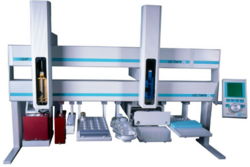Process Monitoring Applications
From LEAP
Current revision (21:22, 4 November 2009) (view source) |
|||
| (7 intermediate revisions not shown.) | |||
| Line 6: | Line 6: | ||
|description = Timed sampling of static or in-stream reaction vessels. Sample Cleanup and injection to detector | |description = Timed sampling of static or in-stream reaction vessels. Sample Cleanup and injection to detector | ||
}} | }} | ||
| + | Normally samples are presented to an analytical instrument in a stable form and in a vial or microwell plate. However, when a reaction is taking place in a vial then obviously a time factor comes into play. For stability testing such as shelf life, monitoring of a digestion process or any other reaction taking place in a container the interest is high to monitor the progression of the reaction. Depending how many and how often data points are needed along that time axes such a process can take a few seconds, minutes, hours day or weeks. The LEAP Shell[http://www.leapwiki.com/mediawiki/index.php?title=Category:LEAP_Shell] software turns a PAL into a precisely scheduled sampling device. Automating a monitoring task adds a high value to the operation. Completely unattended a consistent amount of sample is pulled out of a reaction vessel and either is directly injected into a LC, GC or other analytical device or dispensed into an empty or prepared container. Often that container holds a previously dispensed quenching liquid that stops the ongoing reaction. | ||
| + | |||
| + | A further variation of such a monitoring task is taking a sample from a flow cell. This enables sampling from a loop where liquid circulates in and out of an inaccessible container, large vessel or a process stream. LEAP has experience with such liquid streams at elevated pressures and temperatures and uses suitable accessories such as circulating pumps, flow cells and filters. Single or multiple flow cell arrangements are available. There is also the opportunity to have a smart information feedback to the process depending on each data point acquired. | ||
LEAP offers many different process monitoring capabilities here are examples of a few | LEAP offers many different process monitoring capabilities here are examples of a few | ||
| Line 14: | Line 17: | ||
*[[Monitoring of Polymerization reactions]] | *[[Monitoring of Polymerization reactions]] | ||
| + | |||
| + | |||
| + | ----- | ||
| + | [[Image:LEAP Logo.png|frame|[http://www.leaptec.com leaptec.com]<br />[http://www.leapwiki.com leapwiki.com]]] | ||
| + | === Contact LEAP === | ||
| + | |||
| + | For more information on using the PAL as a scheduled sampling device for the following Application areas: endothermic reactions with enzymes, polymerization R&D, bioprocesses, long-term product stability, discharge self monitoring of waste water, dissolution testing | ||
| + | |||
| + | [[image:Contact_Info.png|40px]] [http://www.leaptec.com/contact-us.php Contact the LEAP office] | ||
| + | |||
| + | |||
| + | [[Category:Accessories]] | ||
| + | [[Category:Process Monitoring]] | ||
Current revision

| Process Monitoring Applications |
| Application Type | |
| STANDARD AND SPECIAL | |
| Application ID | |
| Description | |
| Timed sampling of static or in-stream reaction vessels. Sample Cleanup and injection to detector |
Normally samples are presented to an analytical instrument in a stable form and in a vial or microwell plate. However, when a reaction is taking place in a vial then obviously a time factor comes into play. For stability testing such as shelf life, monitoring of a digestion process or any other reaction taking place in a container the interest is high to monitor the progression of the reaction. Depending how many and how often data points are needed along that time axes such a process can take a few seconds, minutes, hours day or weeks. The LEAP Shell[1] software turns a PAL into a precisely scheduled sampling device. Automating a monitoring task adds a high value to the operation. Completely unattended a consistent amount of sample is pulled out of a reaction vessel and either is directly injected into a LC, GC or other analytical device or dispensed into an empty or prepared container. Often that container holds a previously dispensed quenching liquid that stops the ongoing reaction.
A further variation of such a monitoring task is taking a sample from a flow cell. This enables sampling from a loop where liquid circulates in and out of an inaccessible container, large vessel or a process stream. LEAP has experience with such liquid streams at elevated pressures and temperatures and uses suitable accessories such as circulating pumps, flow cells and filters. Single or multiple flow cell arrangements are available. There is also the opportunity to have a smart information feedback to the process depending on each data point acquired.
LEAP offers many different process monitoring capabilities here are examples of a few
Contact LEAP
For more information on using the PAL as a scheduled sampling device for the following Application areas: endothermic reactions with enzymes, polymerization R&D, bioprocesses, long-term product stability, discharge self monitoring of waste water, dissolution testing

